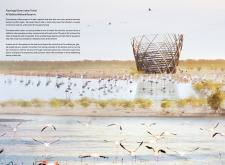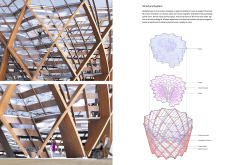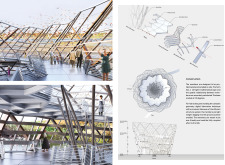5 key facts about this project
The Flamingo Observation Tower, located in the Al Wathba Wetland Reserve, is designed to enhance the connection between visitors and the area's flamingo population. It integrates closely with the natural landscape, allowing people to engage with the environment without disrupting it. The design focuses on creating a space that not only provides shelter but also promotes observation and interaction, serving as a focal point for both education and appreciation of wildlife.
Architectural Concept
The structure features a multi-use layer that offers both protection and visual access to the environment. Its spiral shape facilitates a smooth slope, making the ascent easy for everyone, including those with mobility challenges. As visitors move from the base to the top, they experience a change in atmosphere—from a close, enclosed space to the openness of a viewing platform that encourages engagement with the surroundings.
Site Integration
The boardwalk system is carefully designed to follow existing pathways within the wetland environment. This attention to site integration reduces any negative effects on the natural habitat. The observation tower serves as a central point, guiding foot traffic and connecting to the trails. By aligning itself with the natural movements of wildlife, the design respects the living patterns of the flamingos.
Structural Framework
The tower's structure is composed of multiple layers that provide both strength and stability. The different-sized members are interwoven to create the upward spiral form. The ramp, which is essential for visitor flow, is supported by the inner and outer parts of the structure’s framework. This design choice allows for break points where visitors can pause to take in the views, enhancing their experience.
Construction Methodology
The approach to construction emphasizes the use of prefabricated elements, which ensures a more efficient assembly process. The design relies on precise calculations that respect the relationships between the various components. Modern fabrication techniques allow for complex shapes to be constructed with less material waste. This method is both practical and aligned with environmental considerations, supporting the idea of building responsibly.
Rooftop Viewing Deck
At the top of the tower, a viewing deck offers expansive views of the wetland below. This platform encourages visitors to connect with the landscape, providing a space for quiet reflection on the beauty of the habitat. The design draws attention to the natural environment and highlights the importance of observing and appreciating the wildlife, particularly the flamingos for which the reserve is known.






















































